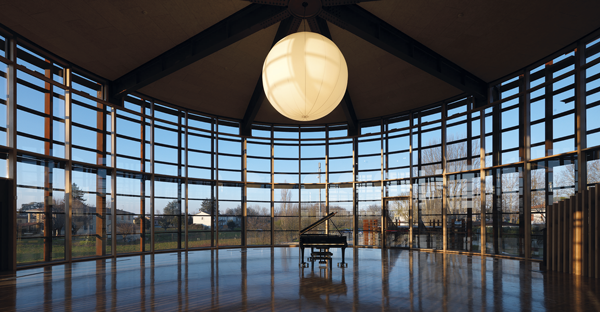Aluminium and wood for the new Sports and Culture Centre in Bondeno
An efficient add-on curtain wall system on wood designed by Schüco Italia characterises the new Multifunctional Art and Culture Centre in Bondeno (near Ferrara), built thanks to a Solidarity Fund for reconstruction following the earthquake.
by Roberto Guccione
The new Multifunctional Art and Culture Centre in Bondeno, a small town in the plain near Ferrara which was severely damaged by the earthquake in 2012, opened on December 18th, completes the network of municipal services offered by this town in Romagna, providing citizens with a new meeting place and a venue for the dissemination of culture. The building was completed thanks to the Emilia Reconstruction Fund, the solidarity fund promoted following the earthquake by the entrepreneurial association Confindustria, the three national trade union federations (CGIL, CISL and UIL) and Confservizi. By means of this financing, the design of the Sports and Culture Centre could be entrusted to the prestigious firm Mario Cucinella Architects, along with other public projects in the area: the dance school in Reggiolo, near Reggio Emilia, the recreational centre in Quistello, near Mantua, the social and health centre in San Felice sul Panaro, near Modena, and the House of Music in Pieve di Cento, opened officially on May 29th by the President of the Republic, Sergio Mattarella. The Sports and Culture Centre is the most important symbol of the rebirth of social life in Bondeno: the new building is found to the east of the city centre, in a strategic area from an urban planning standpoint since it was already characterized by the presence of an important sports structure. Mario Cucinella’s project envisages the presence of cylindrical volumes, accessible and interconnected by means of elevated paths. The architectural shapes are inspired by the rural landscape and by the activities typical of the region, being remindful of the circular bales of hay which dot the fields after reaping. Supported by concrete, steel and wood structures which create evocative circular areas open towards the landscape, the Sports and Culture Centre will host different activities: a gym, theatre, cinema and conference hall. A solar energy plant will help in satisfying the structure’s electricity requirements.
Aluminium and wood for high-performance curtain walls
For the building envelope, the designers chose the Schüco AOC 50 TI.SI system added on to wood, a solution characterized by flexibility, light weight and excellent energy performances. This system was designed to combine aesthetics, transparency and high performances with a minimum thickness of profiles and the possibility of developing very large windows. AOC 50 TI.SI is a system based on aluminium mullions and transoms, presenting a visible section of only 50 mm (or 60 mm), ideal for vertical façades meant to be added on to wooden support structures or, in the ST version, on steel structures. It may reach values of thermal transmittance lower than Uf = 0,8 W/m2K, compliant with the strict requisites of the Passive House certification for vertical façades and roofing areas.
Another important advantage concerns the ease of installation and insulation. Thanks to the new “pivot” installation technique, patented for a rational and simplified installations, the use of heavy glass panes (even triple glazed) is not an issue in terms of size and structure, helping to reduce construction times.
Besides, insulation barriers with liquid sealing have been almost completely eliminated, creating three levels of draining which help the project’s flexibility and provide an effective insulating property to the building envelope. The system is also tested to reach the highest classes against intrusion (up to RC 3) both with steel and wooden underlying structures.
The elements of the system allow high glass loads: up to 810 kg for wood and 1190 kg for steel. These solutions are compatible with the use of the thin covers already available for the FWS 50 and FWS 60 systems and, besides using buffer layers between 06 and 58 mm thick, the glass surfaces may be integrated with solar power modules (BIPV).

